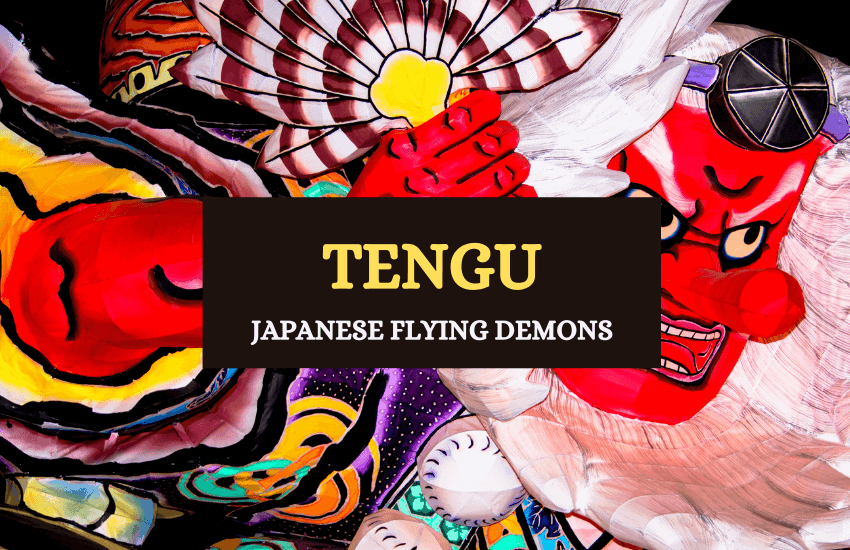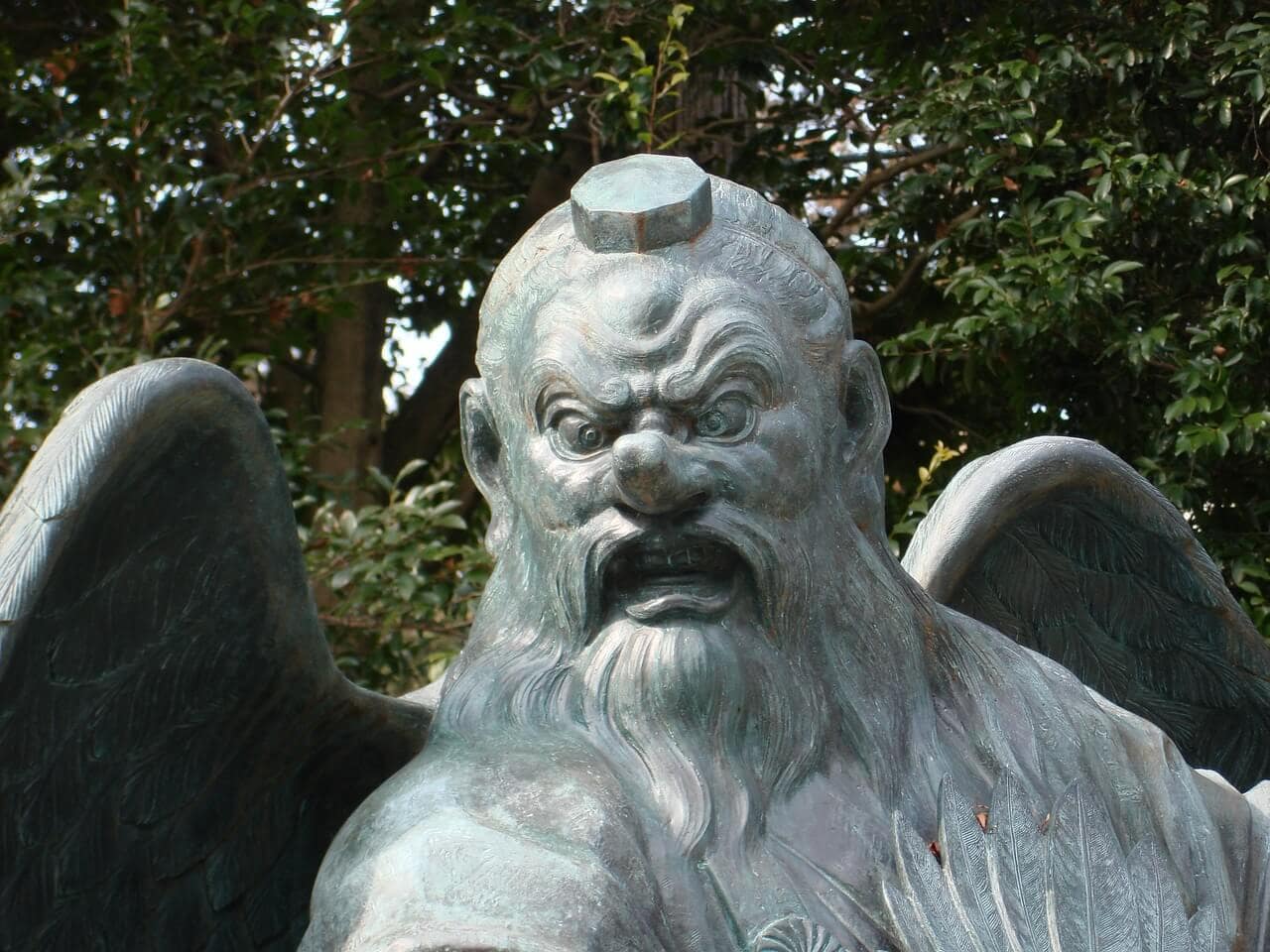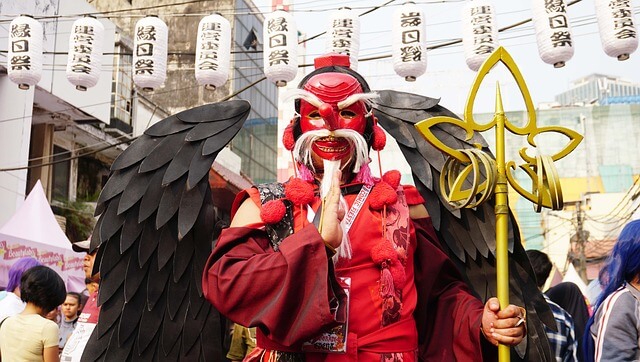
Table of Contents
The Tengu are flying bird-like humanoid yokai (spirits) join Japanese mythology as just minor nuisances. However, they evolved in parallel with Japanese culture and by the end of the 19th century, the Tengu are often viewed as protective demi-gods or minor kami (Shinto gods). The Japanese Tengu spirits are a perfect example of how Japanese mythology often combines bits and pieces from multiple religions to create something uniquely Japanese.
Who Are the Tengu?

Named after a Chinese demon myth about the tiāngǒu (Celestial dog) and shaped after the Hindu eagle deity Garuda, the Japanese Tengu are yokai spirits of Shintoism, as well as one of the greatest antagonists of Japanese Buddhism. If this sounds both fascinating and confusing – welcome to Japanese mythology!
But what exactly are the Tengu?
In short, these Shinto yokai are spirits or demons with bird-like features. In many of their earlier myths, they’re depicted almost entirely with animal characteristics and few, if any, humanoid aspects. Back then, the Tengu were also viewed as simple animal spirits like most other yokai – just a part of nature.
In later myths, however, the idea that the Tengu were the twisted spirits of dead men rose to popularity. About this time, the Tengu started looking more human – from big birds with slightly humanoid torsos, they eventually turned into people with wings and bird heads. A few centuries later, they were depicted, not with bird heads, but only with beaks, and by the end of the Edo period (16th-19th century), they no longer were depicted with bird-like features. Instead of the beaks, they had long noses and red faces.
As the Tengu became more “human” and switched from spirits into demons, they also grew more powerful and complex.
Humble Beginnings – The Minor Yokai Kotengu
The difference between the early Japanese Tengu spirits and the later Tengu demons or minor kami is so stark that many authors describe them as two separate beings – the Kotengu and Diatengu.
- Kotengu – Older Tengu
Kotengu, the older and much more animalistic yokai spirits, are also called Karasutengu, with karasu meaning crow. However, despite the name, the Kotengu weren’t usually modeled after crows, but bore a closer resemblance to large birds of prey such as the Japanese Black kite hawks.
The behavior of the Kotengu was also very similar to that of birds of prey – they were said to attack people at night and often kidnap priests or children.
Like most yokai spirits, however, all Tengu spirits, including the Kotengu had the ability to shapeshift. The Kotengu spent most of their time in their natural form but there are myths about them transforming into people, will-o-wisps, or playing music and weird sounds to try and confuse their prey.
One such early myth tells about a Tengu who transformed into a Buddha in front of a Buddhist minister in the woods. The Tengu/Buddha was sitting on a tree, surrounded by bright light and flying flowers. The clever minister realized it was a trick, however, and instead of getting close to the yokai, he just sat down and stared at it. After about an hour, the Kotengu’s powers withered and the spirit shapeshifted into its original form – a small kestrel bird. It fell on the ground, breaking its wings.
This also goes to show that the early Kotengu weren’t very intelligent, not even by the standard of other animalistic yokai spirits. As Japanese culture developed through the centuries, Kotengu yokai remained a part of its folklore but a second type of Tengu was born – the Diatengu.
- Diatengu – Later Tengu and Intelligent Demons

When most people talk about Tengu yokai today, they usually mean the Diatengu. Much more humanoid than the Kotengu, the Diatengu still had bird heads in their earlier myths but were eventually portrayed as winged demon men with red faces and long noses.
The main difference between the Kotengu and the Diatengu, however, is that the latter are much more intelligent. This is explained in detail in the Genpei Jōsuiki books. There, a Buddhist god appears to a man named Go-Shirakawa and tells him that all Tengu are ghosts of dead Buddhists.
The deity explains that because Buddhists can’t go to Hell, those with “bad principles” among them turn into Tengu instead. Less intelligent people turn into Kotengu, and the learned people – usually priests and nuns – turn into Diatengu.
In their earlier myths, the Diatengu were as evil as the Kotengu – they would kidnap priests and children and would sow all types of mischief. As more intelligent beings, however, they could talk, argue, and even be reasoned with.
Most Diatengu were said to live in secluded mountain forests, usually at the sites of former monasteries or particular historical events. In addition to shapeshifting and flight, they could also possess people, had super-human strength, were expert swordsmen and controlled various types of magic, including wind powers. The latter is particularly iconic and most Diatengu were portrayed carrying a magical feather fan that could cause powerful gushes of wind.
Tengu vs. Buddhism
If the Tengu are yokai spirits in Shintoism, why are most of their myths about Buddhists?
The prevailing theory that answers this question is as simple as it is amusing – Buddhism came into Japan from China, and became a competing religion to Shintoism. Since Shintoism is a religion of countless animalistic spirits, demons, and deities, the Shinto believers invented the Tengu spirits and “gave” them to the Buddhists. For this, they used the name of a Chinese demon and the appearance of a Hindu deity – both of which the Buddhists knew very well.
This may sound somewhat absurd and one may wonder why the Buddhists didn’t just wave this away. In any case, both Kotengu and Diatengu myths became a major part of the Japanese Buddhist folklore. Any unexplained or seemingly supernatural problems the Buddhists encountered were attributed to the Shinto Tengu spirits. This became so serious that often, when two opposing Buddhist sects or monasteries got into disagreements, they’d accuse each other of being Tengu demons shapeshifted into people.
Child Kidnappings – The Dark Reality of the Tengu?
Tengu spirits didn’t just kidnap priests in most myths, however – they’d often kidnap children as well. Especially in later Japanese myths, this theme became very popular and the Tengu switched from mostly tormenting just Buddhist, to being a general nuisance to everybody.
The idea of an ex-priest demon monster kidnapping and tormenting children sounds positively disturbing, especially from today’s perspective. Whether those myths were based on some dark reality, however, is unclear. Most myths don’t include anything as dark as sexual abuse but simply talk about the Tengu “tormenting” children, with some of the children remaining permanently mentally disabled after the incident and others just temporarily unconscious or delirious.
In some later myths, the children are not stated as being unhappy about the mysterious ordeals. One such example comes from the renowned 19th-century author Hirata Atsutane. He tells about his encounter with Torakichi – a Tengu-kidnap victim from a remote mountain village.
Hirata shared that Torakichi was happy he was abducted by the Tengu. The child had said that the winged demon man had been kind to him, took good care of him, and trained him to fight. The Tengu even flew around with the child and the two visited the moon together.
Tengu as Protective Deities and Spirits
Stories like that of Torakichi became more and more popular in later centuries. Whether it was because people enjoyed making fun of Buddhists and their “Tengu problems” or it was just a natural evolution of storytelling, we don’t know.
Another possibility is that because Tengu spirits were territorial and kept to their own remote mountain homes, the people there started viewing them as protective spirits. When an opposing religion, clan, or army tried to get in their territory, the Tengu spirits would attack them, thus protecting the people who already lived there from the invaders.
The prevalence of the more intelligent Daitengu and the fact that they weren’t just animalistic monsters but former people also humanized them to some extent. People started believing that they could reason with the Diatengu spirits. This theme is also seen in later Tengu myths.
Symbolism of Tengu
With many different Tengo characters and myths, as well as entirely different types of Tengu spirits, their meaning and symbolism are quite diverse, often with contradictory representations. These beings have been depicted as evil, morally ambiguous and as benevolent, depending on the myths.
Early Tengu myths seem to have had a very simple theme – big bad monsters to scare children (and Buddhists) with.
From there, the Tengu myths evolved to represent them as more intelligent and sinister beings but their goals were still mostly to bother people and protect the Tengu’s territory. Being described as the spirits of dead evil men in later myths, Tengu also represented the dark fate of people with bad morals.
As for the Tengu myths that also described them as morally-ambiguous and mysterious mentors and protective spirits – that’s a common representation of many yokai spirits in Shintoism.
Importance of Tengu in Modern Culture
In addition to all the Tengo myths and legends that kept popping up in Japanese folklore until the 19th century and beyond, Tengu demons are also represented in modern Japanese culture.
Many modern anime and manga series have at least one Tengu-themed or inspired secondary or tertiary character, recognizable by their long nose and red face. Most aren’t main characters, of course, but are usually restricted to side “trickster” villain roles.
Some of the more popular examples include the animes One Punch Man, Urusei Yatsura, Devil Lady, as well as the more famous series to western audiences Mighty Morphin Power Rangers.
Wrapping Up
The Tengu are interesting figures of Japanese mythology, whose depictions evolved over the years from ancient evil origins to more protective spirits. They hold significance in both Buddhism and Shintoism, and are deeply embedded in Japanese culture and imagination.








